Tell us about your workspace.
I work in a studio at the end of a long, productive garden. Just walking down the garden path to the studio can be informative and inspiring.
My studio’s a little world on its own. I listen to a lot of music when I’m working – anything from Benjamin Britten to Captain Beefheart. I like music that’s difficult to describe and impossible to categorise. The sort of music that reminds you there are no rules: everything is possible, everything is waiting to be done all over again, but differently this time, because whilst you weren’t looking the world changed and you changed too.
The most important thing I find in my studio is the time and space to paint.
Describe your creative process. Do you work with a particular routine?
During the last few years I regularly made lots of drawings of flowers and leaves on tissue paper from unwanted dress patterns using a fine-nibbed permanent marker. Once I had primed the surface I was working on, I would start pasting tissue paper onto the surface, often using the printed lines found on the dress patterns to give structure to my work: to make shapes, and build some sort of framework to play off other elements. Sometimes I would leave words and numbers from the dress patterns as part of the composition.
More recently, however, I have bypassed the tissue paper stage and drawn directly onto the surface I intend to paint on. I use acrylic paint, primarily because it dries quickly. I make changes rapidly when I am working, particularly in the early stages of a painting, and build my pictures in layers of tissue and paint. It’s important, therefore, that I use materials that PVA glue will adhere to well.
As the painting progresses, I draw and redraw shapes on the canvas, add new drawn images on tissue paper and make continual adjustments. My workman-like approach to painting leads me on to the next thing, and that’s how I progress. I often have five or six painting simultaneously in progress.
I don’t have a predetermined goal when I start work. I only know that a painting is finished when it seems there is nothing else to do: the painting has found its own reason for existing, and makes sense according to its own internal logic. At that point it stops being interesting for me. Luckily I’ll have others on the go demanding my attention.


